Audit and Assurance Report: LTH, MSL LTD, and Auditor Independence
VerifiedAdded on 2020/01/07
|9
|2324
|41
Report
AI Summary
This report provides an in-depth analysis of audit and assurance practices, focusing on auditor independence and business risks. It evaluates threats to auditor independence, such as self-interest, familiarity, and employment issues, while also exploring safeguards like professional training and quality control. The report examines business risks for MSL LTD, specifically concerning equipment and spare parts purchases, including poor quality and legal risks. It also identifies associated audit risks, such as system audits, process changes, and product quality issues, emphasizing their impact on account balances. The report concludes by highlighting the significance of audit and financial information for business effectiveness and stakeholder relationships, underscoring the importance of sound financial reporting and the role of audits in maintaining strong business practices.
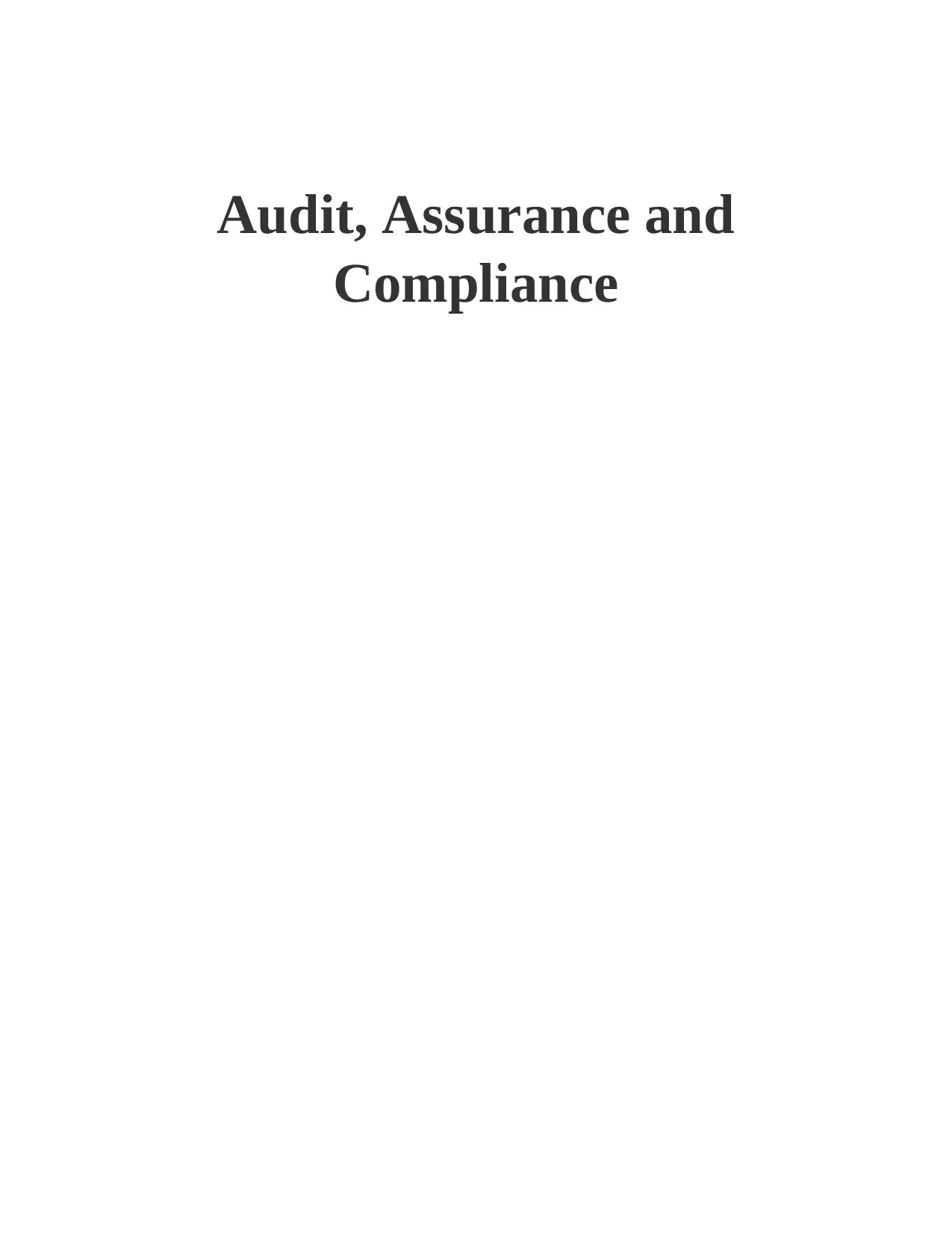
Audit, Assurance and
Compliance
Compliance
Paraphrase This Document
Need a fresh take? Get an instant paraphrase of this document with our AI Paraphraser
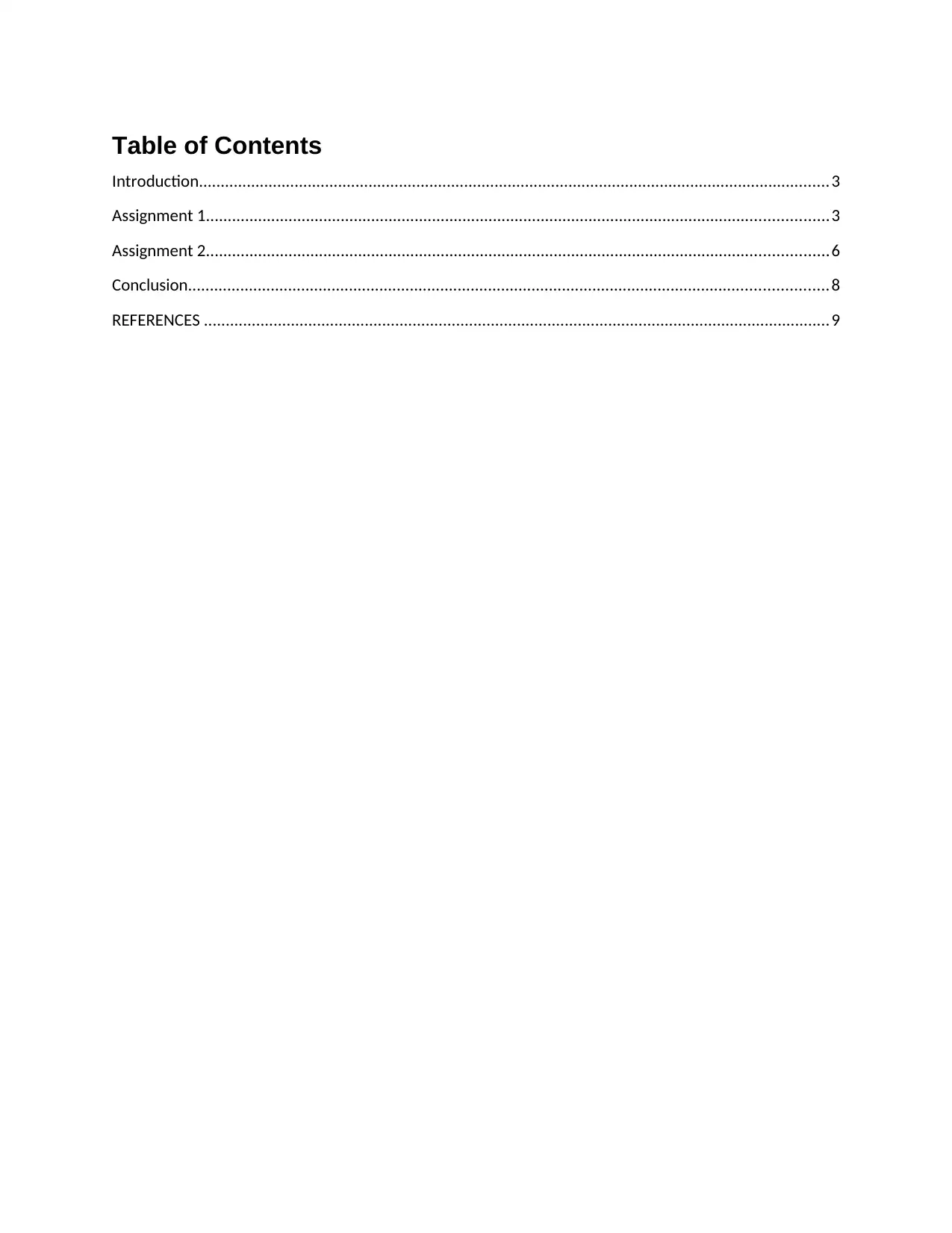
Table of Contents
Introduction.................................................................................................................................................3
Assignment 1...............................................................................................................................................3
Assignment 2...............................................................................................................................................6
Conclusion...................................................................................................................................................8
REFERENCES ................................................................................................................................................9
Introduction.................................................................................................................................................3
Assignment 1...............................................................................................................................................3
Assignment 2...............................................................................................................................................6
Conclusion...................................................................................................................................................8
REFERENCES ................................................................................................................................................9
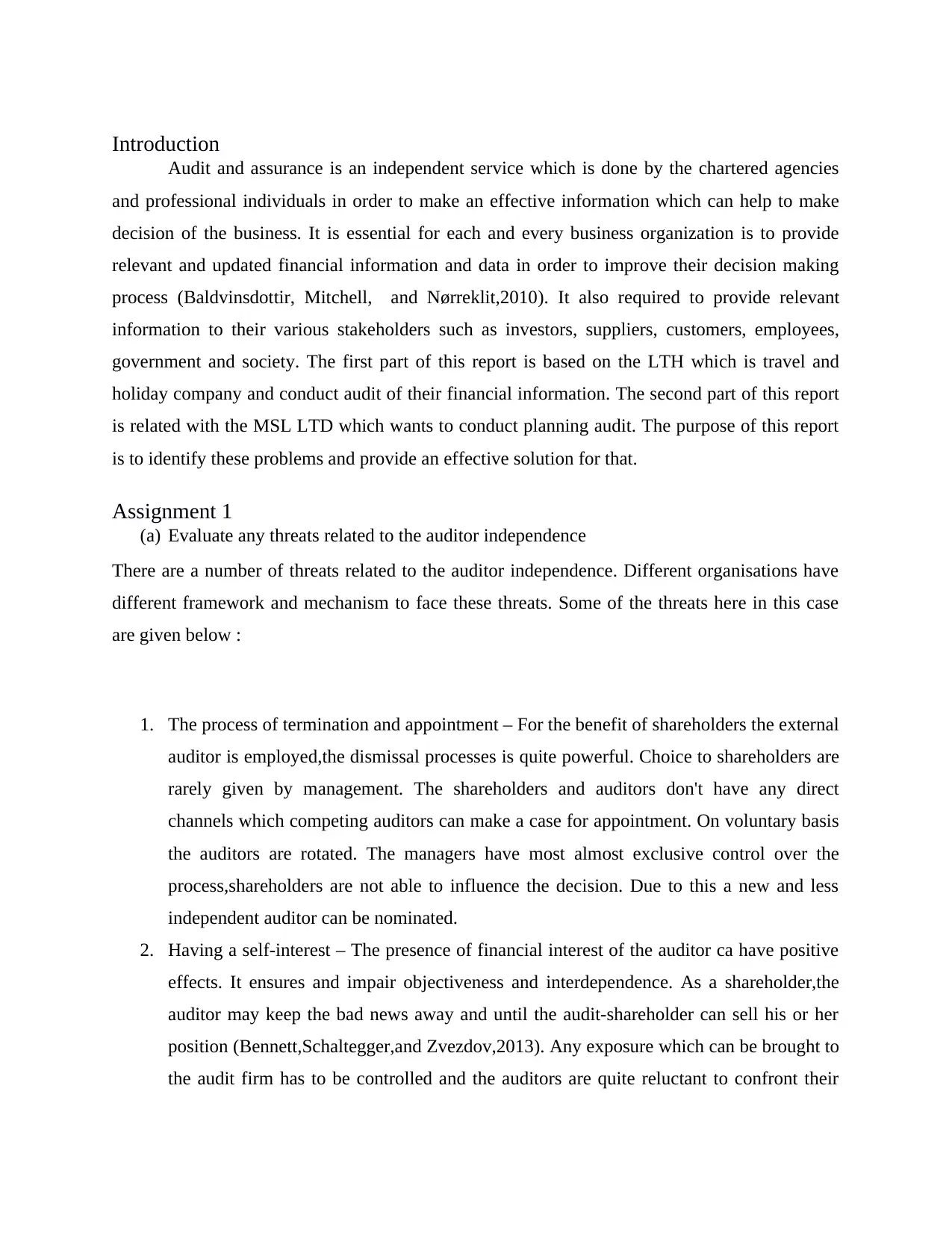
Introduction
Audit and assurance is an independent service which is done by the chartered agencies
and professional individuals in order to make an effective information which can help to make
decision of the business. It is essential for each and every business organization is to provide
relevant and updated financial information and data in order to improve their decision making
process (Baldvinsdottir, Mitchell, and Nørreklit,2010). It also required to provide relevant
information to their various stakeholders such as investors, suppliers, customers, employees,
government and society. The first part of this report is based on the LTH which is travel and
holiday company and conduct audit of their financial information. The second part of this report
is related with the MSL LTD which wants to conduct planning audit. The purpose of this report
is to identify these problems and provide an effective solution for that.
Assignment 1
(a) Evaluate any threats related to the auditor independence
There are a number of threats related to the auditor independence. Different organisations have
different framework and mechanism to face these threats. Some of the threats here in this case
are given below :
1. The process of termination and appointment – For the benefit of shareholders the external
auditor is employed,the dismissal processes is quite powerful. Choice to shareholders are
rarely given by management. The shareholders and auditors don't have any direct
channels which competing auditors can make a case for appointment. On voluntary basis
the auditors are rotated. The managers have most almost exclusive control over the
process,shareholders are not able to influence the decision. Due to this a new and less
independent auditor can be nominated.
2. Having a self-interest – The presence of financial interest of the auditor ca have positive
effects. It ensures and impair objectiveness and interdependence. As a shareholder,the
auditor may keep the bad news away and until the audit-shareholder can sell his or her
position (Bennett,Schaltegger,and Zvezdov,2013). Any exposure which can be brought to
the audit firm has to be controlled and the auditors are quite reluctant to confront their
Audit and assurance is an independent service which is done by the chartered agencies
and professional individuals in order to make an effective information which can help to make
decision of the business. It is essential for each and every business organization is to provide
relevant and updated financial information and data in order to improve their decision making
process (Baldvinsdottir, Mitchell, and Nørreklit,2010). It also required to provide relevant
information to their various stakeholders such as investors, suppliers, customers, employees,
government and society. The first part of this report is based on the LTH which is travel and
holiday company and conduct audit of their financial information. The second part of this report
is related with the MSL LTD which wants to conduct planning audit. The purpose of this report
is to identify these problems and provide an effective solution for that.
Assignment 1
(a) Evaluate any threats related to the auditor independence
There are a number of threats related to the auditor independence. Different organisations have
different framework and mechanism to face these threats. Some of the threats here in this case
are given below :
1. The process of termination and appointment – For the benefit of shareholders the external
auditor is employed,the dismissal processes is quite powerful. Choice to shareholders are
rarely given by management. The shareholders and auditors don't have any direct
channels which competing auditors can make a case for appointment. On voluntary basis
the auditors are rotated. The managers have most almost exclusive control over the
process,shareholders are not able to influence the decision. Due to this a new and less
independent auditor can be nominated.
2. Having a self-interest – The presence of financial interest of the auditor ca have positive
effects. It ensures and impair objectiveness and interdependence. As a shareholder,the
auditor may keep the bad news away and until the audit-shareholder can sell his or her
position (Bennett,Schaltegger,and Zvezdov,2013). Any exposure which can be brought to
the audit firm has to be controlled and the auditors are quite reluctant to confront their
⊘ This is a preview!⊘
Do you want full access?
Subscribe today to unlock all pages.

Trusted by 1+ million students worldwide
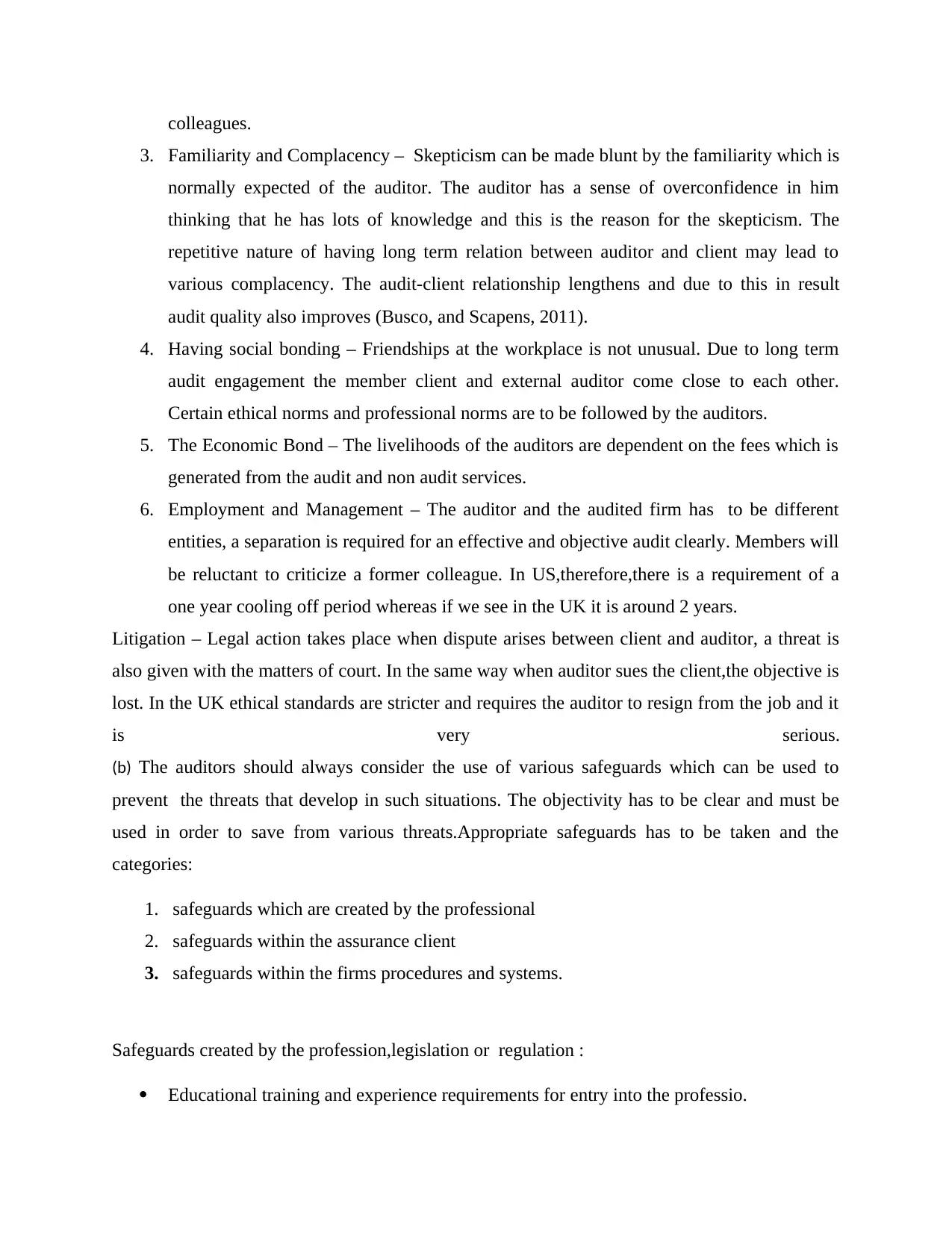
colleagues.
3. Familiarity and Complacency – Skepticism can be made blunt by the familiarity which is
normally expected of the auditor. The auditor has a sense of overconfidence in him
thinking that he has lots of knowledge and this is the reason for the skepticism. The
repetitive nature of having long term relation between auditor and client may lead to
various complacency. The audit-client relationship lengthens and due to this in result
audit quality also improves (Busco, and Scapens, 2011).
4. Having social bonding – Friendships at the workplace is not unusual. Due to long term
audit engagement the member client and external auditor come close to each other.
Certain ethical norms and professional norms are to be followed by the auditors.
5. The Economic Bond – The livelihoods of the auditors are dependent on the fees which is
generated from the audit and non audit services.
6. Employment and Management – The auditor and the audited firm has to be different
entities, a separation is required for an effective and objective audit clearly. Members will
be reluctant to criticize a former colleague. In US,therefore,there is a requirement of a
one year cooling off period whereas if we see in the UK it is around 2 years.
Litigation – Legal action takes place when dispute arises between client and auditor, a threat is
also given with the matters of court. In the same way when auditor sues the client,the objective is
lost. In the UK ethical standards are stricter and requires the auditor to resign from the job and it
is very serious.
(b) The auditors should always consider the use of various safeguards which can be used to
prevent the threats that develop in such situations. The objectivity has to be clear and must be
used in order to save from various threats.Appropriate safeguards has to be taken and the
categories:
1. safeguards which are created by the professional
2. safeguards within the assurance client
3. safeguards within the firms procedures and systems.
Safeguards created by the profession,legislation or regulation :
Educational training and experience requirements for entry into the professio.
3. Familiarity and Complacency – Skepticism can be made blunt by the familiarity which is
normally expected of the auditor. The auditor has a sense of overconfidence in him
thinking that he has lots of knowledge and this is the reason for the skepticism. The
repetitive nature of having long term relation between auditor and client may lead to
various complacency. The audit-client relationship lengthens and due to this in result
audit quality also improves (Busco, and Scapens, 2011).
4. Having social bonding – Friendships at the workplace is not unusual. Due to long term
audit engagement the member client and external auditor come close to each other.
Certain ethical norms and professional norms are to be followed by the auditors.
5. The Economic Bond – The livelihoods of the auditors are dependent on the fees which is
generated from the audit and non audit services.
6. Employment and Management – The auditor and the audited firm has to be different
entities, a separation is required for an effective and objective audit clearly. Members will
be reluctant to criticize a former colleague. In US,therefore,there is a requirement of a
one year cooling off period whereas if we see in the UK it is around 2 years.
Litigation – Legal action takes place when dispute arises between client and auditor, a threat is
also given with the matters of court. In the same way when auditor sues the client,the objective is
lost. In the UK ethical standards are stricter and requires the auditor to resign from the job and it
is very serious.
(b) The auditors should always consider the use of various safeguards which can be used to
prevent the threats that develop in such situations. The objectivity has to be clear and must be
used in order to save from various threats.Appropriate safeguards has to be taken and the
categories:
1. safeguards which are created by the professional
2. safeguards within the assurance client
3. safeguards within the firms procedures and systems.
Safeguards created by the profession,legislation or regulation :
Educational training and experience requirements for entry into the professio.
Paraphrase This Document
Need a fresh take? Get an instant paraphrase of this document with our AI Paraphraser
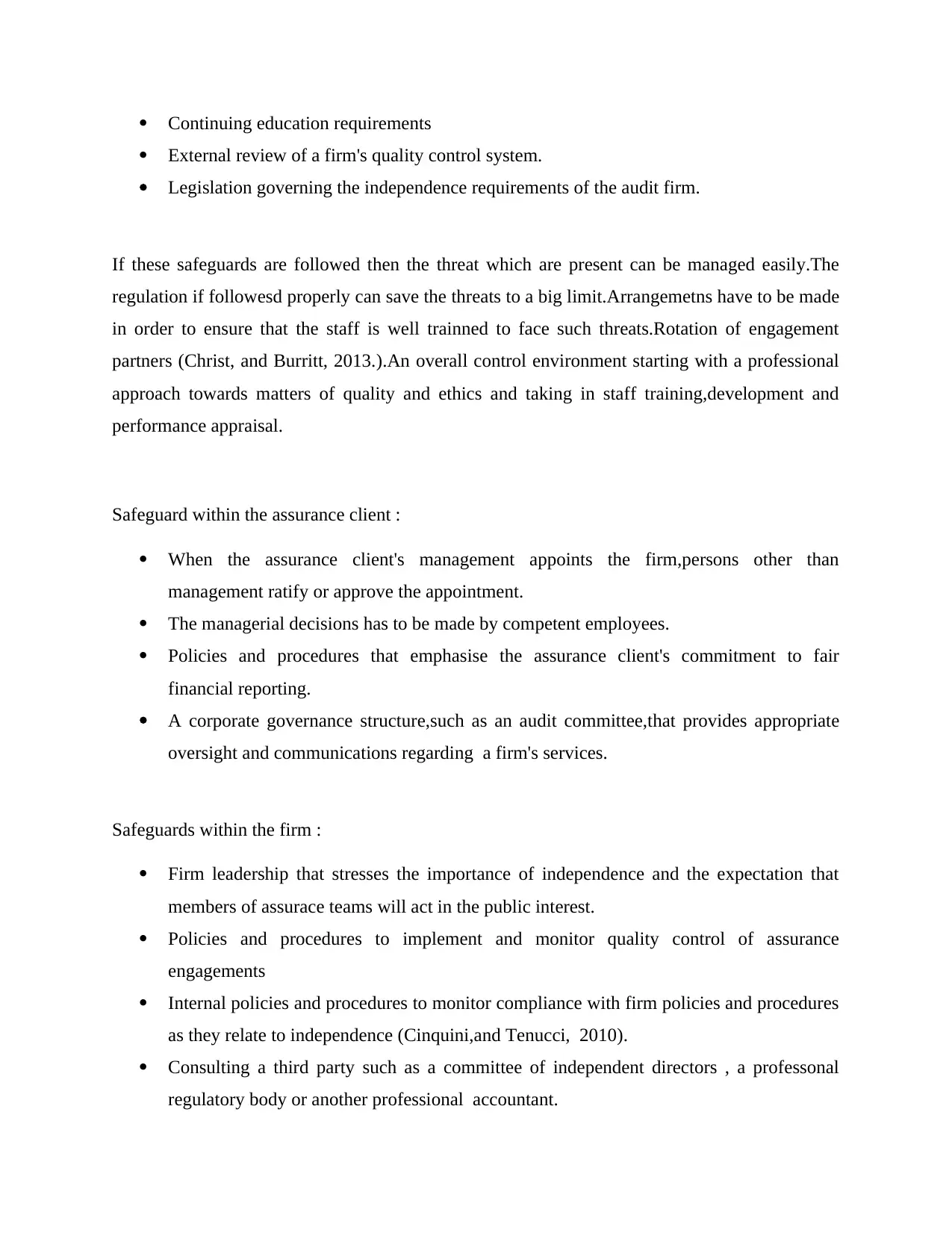
Continuing education requirements
External review of a firm's quality control system.
Legislation governing the independence requirements of the audit firm.
If these safeguards are followed then the threat which are present can be managed easily.The
regulation if followesd properly can save the threats to a big limit.Arrangemetns have to be made
in order to ensure that the staff is well trainned to face such threats.Rotation of engagement
partners (Christ, and Burritt, 2013.).An overall control environment starting with a professional
approach towards matters of quality and ethics and taking in staff training,development and
performance appraisal.
Safeguard within the assurance client :
When the assurance client's management appoints the firm,persons other than
management ratify or approve the appointment.
The managerial decisions has to be made by competent employees.
Policies and procedures that emphasise the assurance client's commitment to fair
financial reporting.
A corporate governance structure,such as an audit committee,that provides appropriate
oversight and communications regarding a firm's services.
Safeguards within the firm :
Firm leadership that stresses the importance of independence and the expectation that
members of assurace teams will act in the public interest.
Policies and procedures to implement and monitor quality control of assurance
engagements
Internal policies and procedures to monitor compliance with firm policies and procedures
as they relate to independence (Cinquini,and Tenucci, 2010).
Consulting a third party such as a committee of independent directors , a professonal
regulatory body or another professional accountant.
External review of a firm's quality control system.
Legislation governing the independence requirements of the audit firm.
If these safeguards are followed then the threat which are present can be managed easily.The
regulation if followesd properly can save the threats to a big limit.Arrangemetns have to be made
in order to ensure that the staff is well trainned to face such threats.Rotation of engagement
partners (Christ, and Burritt, 2013.).An overall control environment starting with a professional
approach towards matters of quality and ethics and taking in staff training,development and
performance appraisal.
Safeguard within the assurance client :
When the assurance client's management appoints the firm,persons other than
management ratify or approve the appointment.
The managerial decisions has to be made by competent employees.
Policies and procedures that emphasise the assurance client's commitment to fair
financial reporting.
A corporate governance structure,such as an audit committee,that provides appropriate
oversight and communications regarding a firm's services.
Safeguards within the firm :
Firm leadership that stresses the importance of independence and the expectation that
members of assurace teams will act in the public interest.
Policies and procedures to implement and monitor quality control of assurance
engagements
Internal policies and procedures to monitor compliance with firm policies and procedures
as they relate to independence (Cinquini,and Tenucci, 2010).
Consulting a third party such as a committee of independent directors , a professonal
regulatory body or another professional accountant.
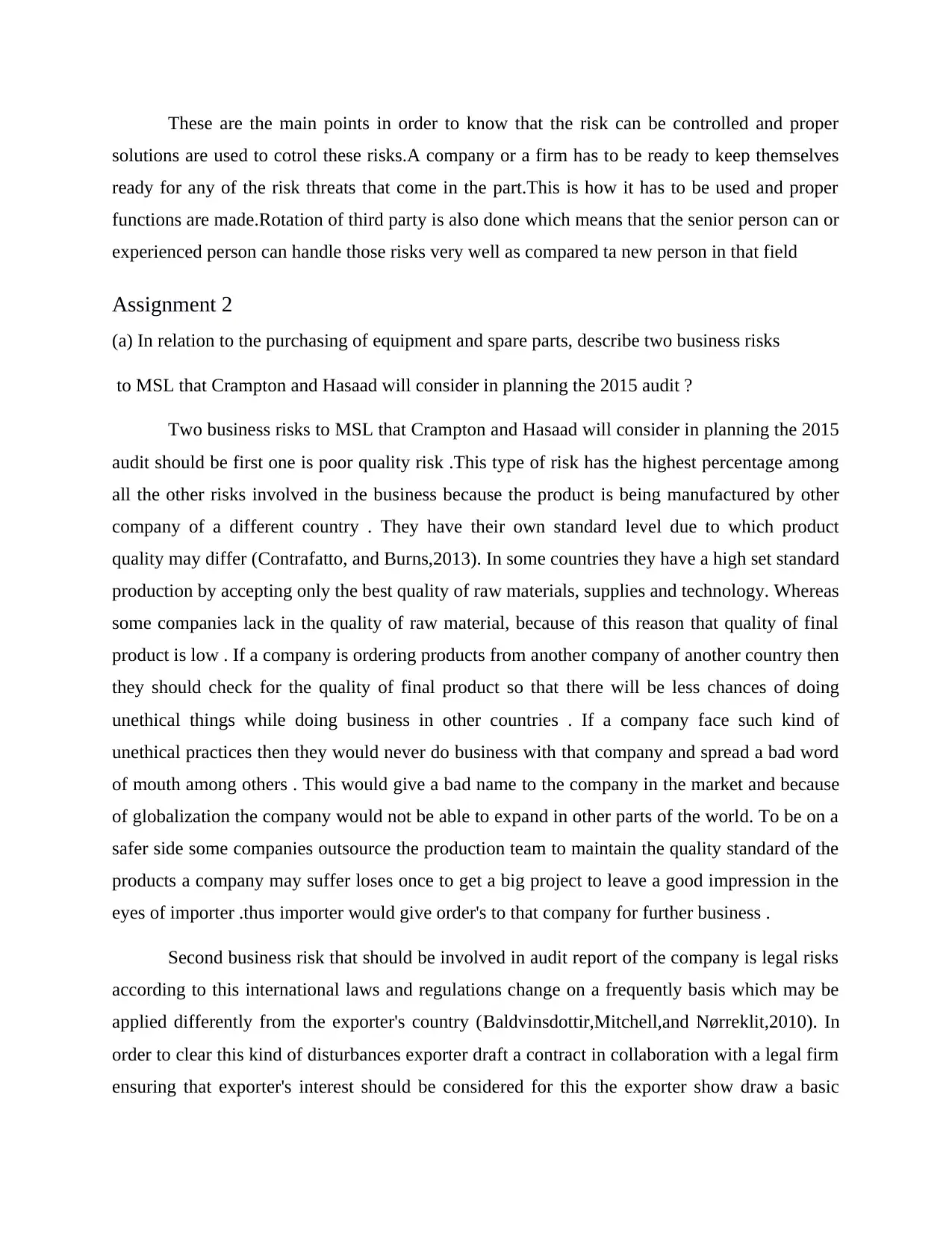
These are the main points in order to know that the risk can be controlled and proper
solutions are used to cotrol these risks.A company or a firm has to be ready to keep themselves
ready for any of the risk threats that come in the part.This is how it has to be used and proper
functions are made.Rotation of third party is also done which means that the senior person can or
experienced person can handle those risks very well as compared ta new person in that field
Assignment 2
(a) In relation to the purchasing of equipment and spare parts, describe two business risks
to MSL that Crampton and Hasaad will consider in planning the 2015 audit ?
Two business risks to MSL that Crampton and Hasaad will consider in planning the 2015
audit should be first one is poor quality risk .This type of risk has the highest percentage among
all the other risks involved in the business because the product is being manufactured by other
company of a different country . They have their own standard level due to which product
quality may differ (Contrafatto, and Burns,2013). In some countries they have a high set standard
production by accepting only the best quality of raw materials, supplies and technology. Whereas
some companies lack in the quality of raw material, because of this reason that quality of final
product is low . If a company is ordering products from another company of another country then
they should check for the quality of final product so that there will be less chances of doing
unethical things while doing business in other countries . If a company face such kind of
unethical practices then they would never do business with that company and spread a bad word
of mouth among others . This would give a bad name to the company in the market and because
of globalization the company would not be able to expand in other parts of the world. To be on a
safer side some companies outsource the production team to maintain the quality standard of the
products a company may suffer loses once to get a big project to leave a good impression in the
eyes of importer .thus importer would give order's to that company for further business .
Second business risk that should be involved in audit report of the company is legal risks
according to this international laws and regulations change on a frequently basis which may be
applied differently from the exporter's country (Baldvinsdottir,Mitchell,and Nørreklit,2010). In
order to clear this kind of disturbances exporter draft a contract in collaboration with a legal firm
ensuring that exporter's interest should be considered for this the exporter show draw a basic
solutions are used to cotrol these risks.A company or a firm has to be ready to keep themselves
ready for any of the risk threats that come in the part.This is how it has to be used and proper
functions are made.Rotation of third party is also done which means that the senior person can or
experienced person can handle those risks very well as compared ta new person in that field
Assignment 2
(a) In relation to the purchasing of equipment and spare parts, describe two business risks
to MSL that Crampton and Hasaad will consider in planning the 2015 audit ?
Two business risks to MSL that Crampton and Hasaad will consider in planning the 2015
audit should be first one is poor quality risk .This type of risk has the highest percentage among
all the other risks involved in the business because the product is being manufactured by other
company of a different country . They have their own standard level due to which product
quality may differ (Contrafatto, and Burns,2013). In some countries they have a high set standard
production by accepting only the best quality of raw materials, supplies and technology. Whereas
some companies lack in the quality of raw material, because of this reason that quality of final
product is low . If a company is ordering products from another company of another country then
they should check for the quality of final product so that there will be less chances of doing
unethical things while doing business in other countries . If a company face such kind of
unethical practices then they would never do business with that company and spread a bad word
of mouth among others . This would give a bad name to the company in the market and because
of globalization the company would not be able to expand in other parts of the world. To be on a
safer side some companies outsource the production team to maintain the quality standard of the
products a company may suffer loses once to get a big project to leave a good impression in the
eyes of importer .thus importer would give order's to that company for further business .
Second business risk that should be involved in audit report of the company is legal risks
according to this international laws and regulations change on a frequently basis which may be
applied differently from the exporter's country (Baldvinsdottir,Mitchell,and Nørreklit,2010). In
order to clear this kind of disturbances exporter draft a contract in collaboration with a legal firm
ensuring that exporter's interest should be considered for this the exporter show draw a basic
⊘ This is a preview!⊘
Do you want full access?
Subscribe today to unlock all pages.

Trusted by 1+ million students worldwide
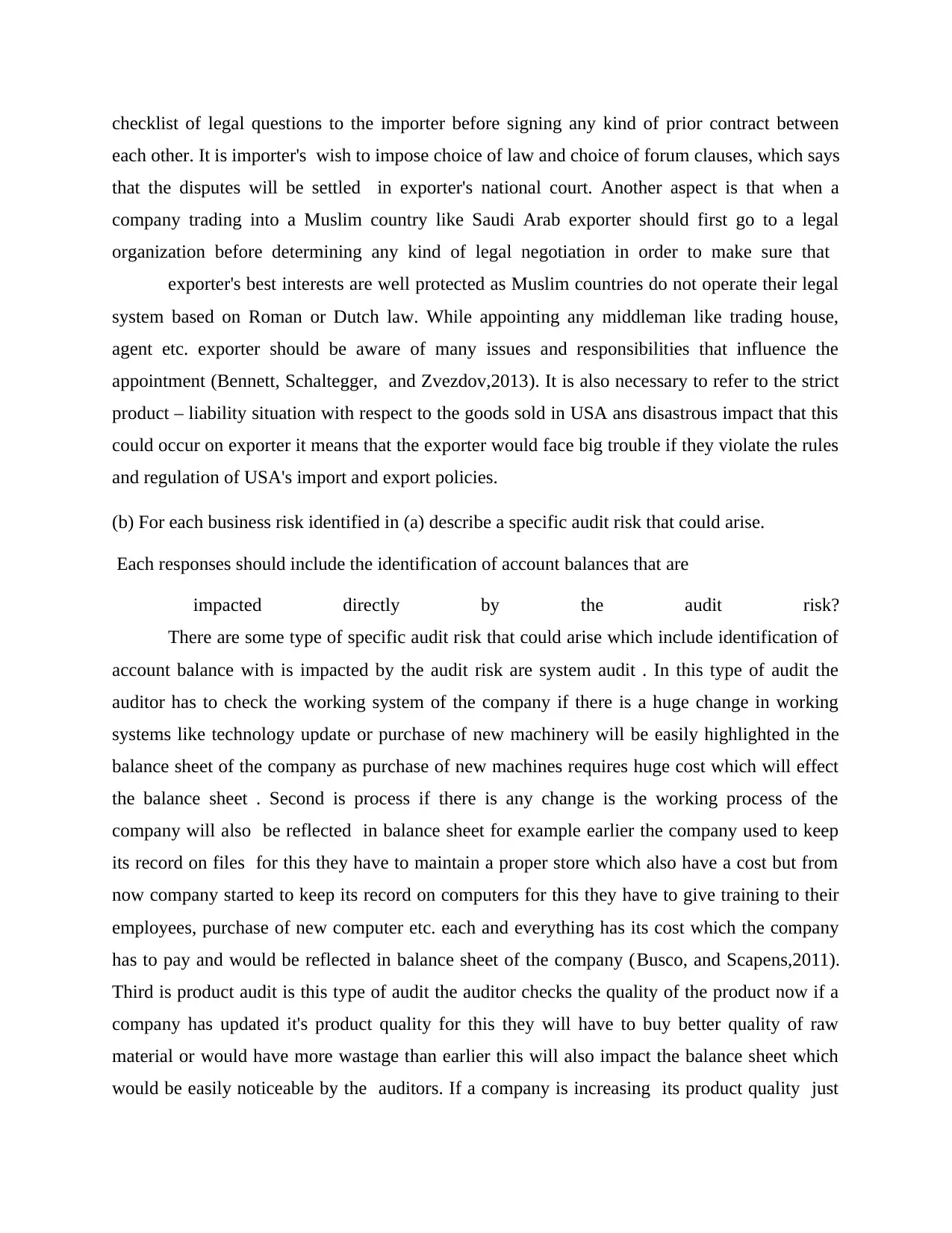
checklist of legal questions to the importer before signing any kind of prior contract between
each other. It is importer's wish to impose choice of law and choice of forum clauses, which says
that the disputes will be settled in exporter's national court. Another aspect is that when a
company trading into a Muslim country like Saudi Arab exporter should first go to a legal
organization before determining any kind of legal negotiation in order to make sure that
exporter's best interests are well protected as Muslim countries do not operate their legal
system based on Roman or Dutch law. While appointing any middleman like trading house,
agent etc. exporter should be aware of many issues and responsibilities that influence the
appointment (Bennett, Schaltegger, and Zvezdov,2013). It is also necessary to refer to the strict
product – liability situation with respect to the goods sold in USA ans disastrous impact that this
could occur on exporter it means that the exporter would face big trouble if they violate the rules
and regulation of USA's import and export policies.
(b) For each business risk identified in (a) describe a specific audit risk that could arise.
Each responses should include the identification of account balances that are
impacted directly by the audit risk?
There are some type of specific audit risk that could arise which include identification of
account balance with is impacted by the audit risk are system audit . In this type of audit the
auditor has to check the working system of the company if there is a huge change in working
systems like technology update or purchase of new machinery will be easily highlighted in the
balance sheet of the company as purchase of new machines requires huge cost which will effect
the balance sheet . Second is process if there is any change is the working process of the
company will also be reflected in balance sheet for example earlier the company used to keep
its record on files for this they have to maintain a proper store which also have a cost but from
now company started to keep its record on computers for this they have to give training to their
employees, purchase of new computer etc. each and everything has its cost which the company
has to pay and would be reflected in balance sheet of the company (Busco, and Scapens,2011).
Third is product audit is this type of audit the auditor checks the quality of the product now if a
company has updated it's product quality for this they will have to buy better quality of raw
material or would have more wastage than earlier this will also impact the balance sheet which
would be easily noticeable by the auditors. If a company is increasing its product quality just
each other. It is importer's wish to impose choice of law and choice of forum clauses, which says
that the disputes will be settled in exporter's national court. Another aspect is that when a
company trading into a Muslim country like Saudi Arab exporter should first go to a legal
organization before determining any kind of legal negotiation in order to make sure that
exporter's best interests are well protected as Muslim countries do not operate their legal
system based on Roman or Dutch law. While appointing any middleman like trading house,
agent etc. exporter should be aware of many issues and responsibilities that influence the
appointment (Bennett, Schaltegger, and Zvezdov,2013). It is also necessary to refer to the strict
product – liability situation with respect to the goods sold in USA ans disastrous impact that this
could occur on exporter it means that the exporter would face big trouble if they violate the rules
and regulation of USA's import and export policies.
(b) For each business risk identified in (a) describe a specific audit risk that could arise.
Each responses should include the identification of account balances that are
impacted directly by the audit risk?
There are some type of specific audit risk that could arise which include identification of
account balance with is impacted by the audit risk are system audit . In this type of audit the
auditor has to check the working system of the company if there is a huge change in working
systems like technology update or purchase of new machinery will be easily highlighted in the
balance sheet of the company as purchase of new machines requires huge cost which will effect
the balance sheet . Second is process if there is any change is the working process of the
company will also be reflected in balance sheet for example earlier the company used to keep
its record on files for this they have to maintain a proper store which also have a cost but from
now company started to keep its record on computers for this they have to give training to their
employees, purchase of new computer etc. each and everything has its cost which the company
has to pay and would be reflected in balance sheet of the company (Busco, and Scapens,2011).
Third is product audit is this type of audit the auditor checks the quality of the product now if a
company has updated it's product quality for this they will have to buy better quality of raw
material or would have more wastage than earlier this will also impact the balance sheet which
would be easily noticeable by the auditors. If a company is increasing its product quality just
Paraphrase This Document
Need a fresh take? Get an instant paraphrase of this document with our AI Paraphraser
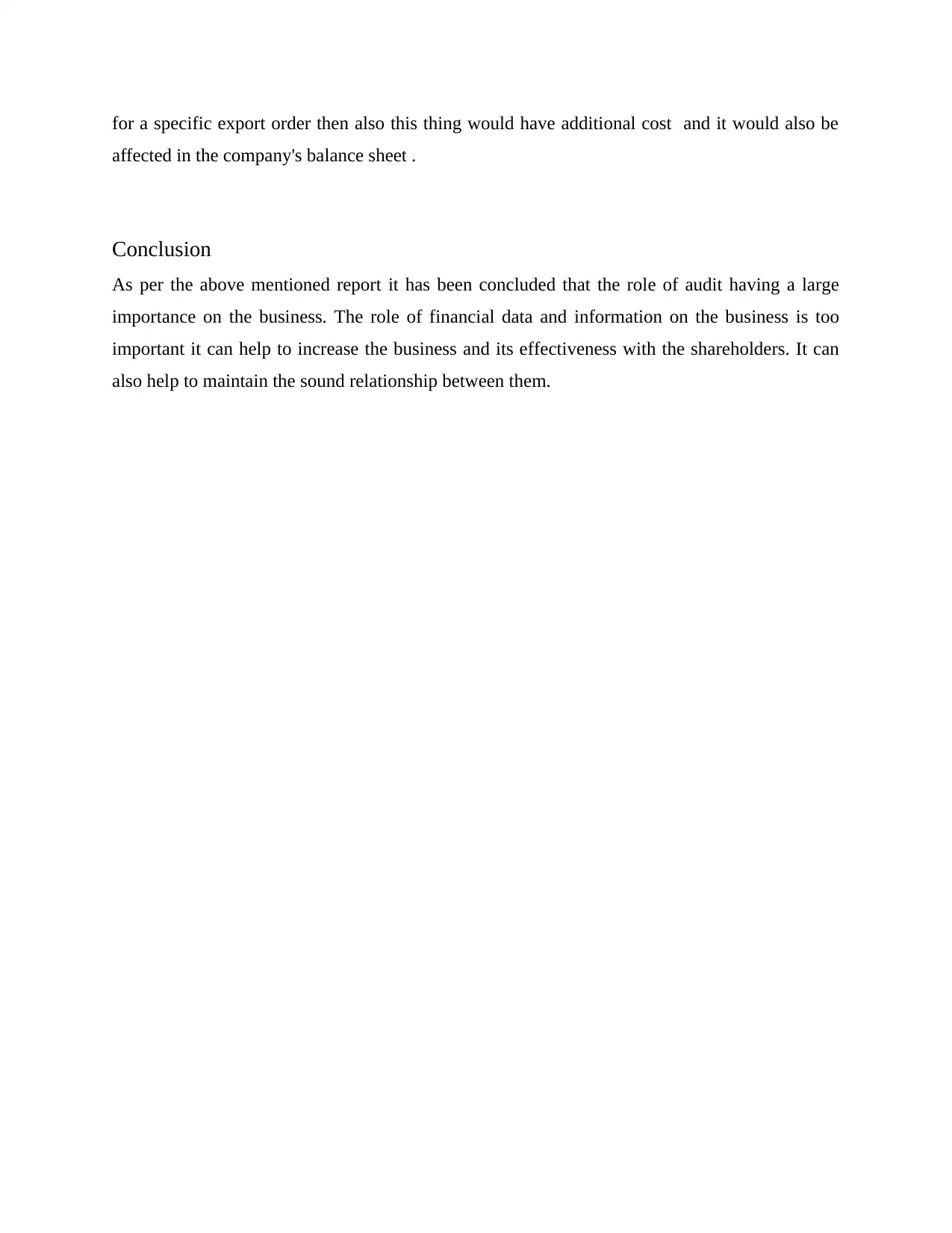
for a specific export order then also this thing would have additional cost and it would also be
affected in the company's balance sheet .
Conclusion
As per the above mentioned report it has been concluded that the role of audit having a large
importance on the business. The role of financial data and information on the business is too
important it can help to increase the business and its effectiveness with the shareholders. It can
also help to maintain the sound relationship between them.
affected in the company's balance sheet .
Conclusion
As per the above mentioned report it has been concluded that the role of audit having a large
importance on the business. The role of financial data and information on the business is too
important it can help to increase the business and its effectiveness with the shareholders. It can
also help to maintain the sound relationship between them.
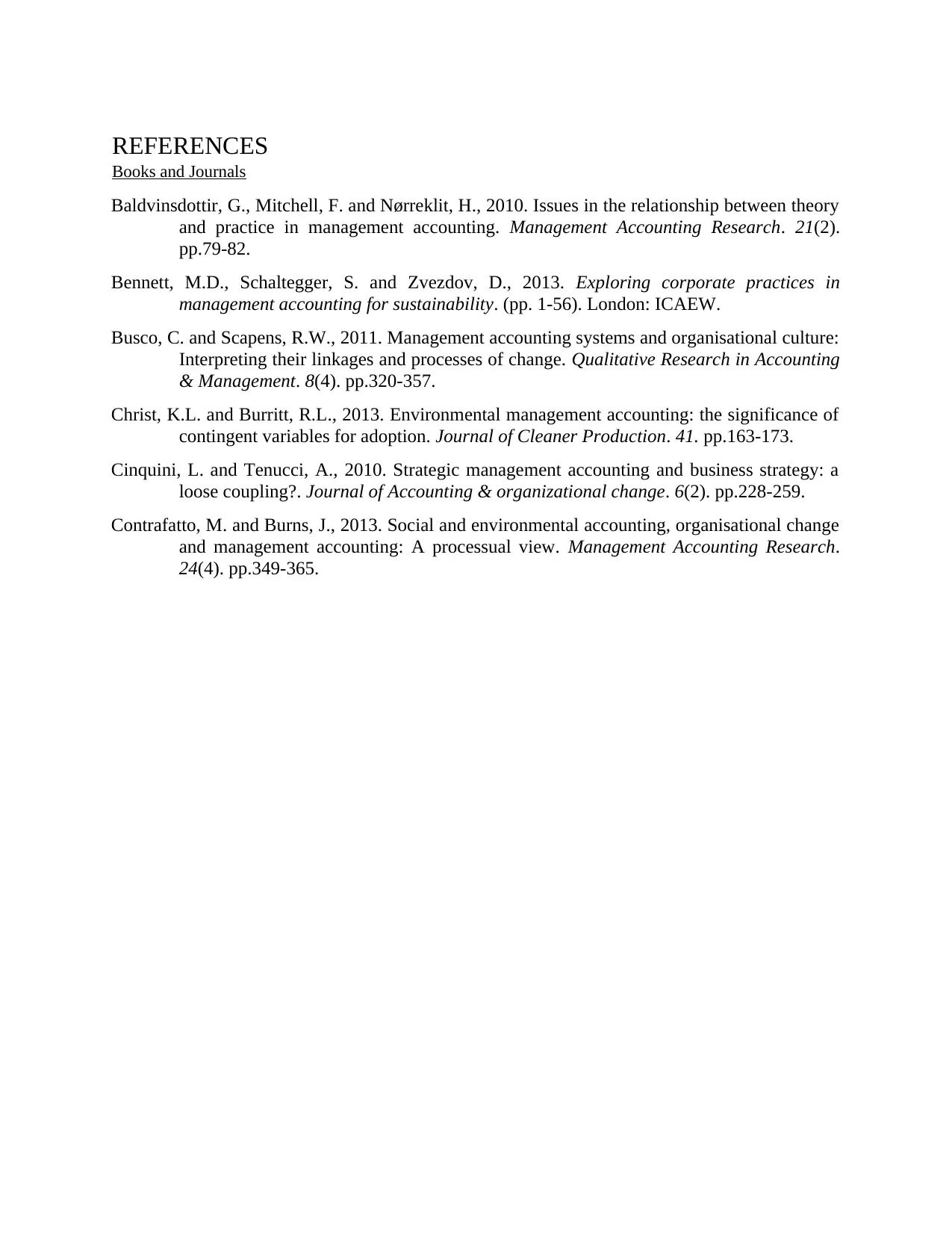
REFERENCES
Books and Journals
Baldvinsdottir, G., Mitchell, F. and Nørreklit, H., 2010. Issues in the relationship between theory
and practice in management accounting. Management Accounting Research. 21(2).
pp.79-82.
Bennett, M.D., Schaltegger, S. and Zvezdov, D., 2013. Exploring corporate practices in
management accounting for sustainability. (pp. 1-56). London: ICAEW.
Busco, C. and Scapens, R.W., 2011. Management accounting systems and organisational culture:
Interpreting their linkages and processes of change. Qualitative Research in Accounting
& Management. 8(4). pp.320-357.
Christ, K.L. and Burritt, R.L., 2013. Environmental management accounting: the significance of
contingent variables for adoption. Journal of Cleaner Production. 41. pp.163-173.
Cinquini, L. and Tenucci, A., 2010. Strategic management accounting and business strategy: a
loose coupling?. Journal of Accounting & organizational change. 6(2). pp.228-259.
Contrafatto, M. and Burns, J., 2013. Social and environmental accounting, organisational change
and management accounting: A processual view. Management Accounting Research.
24(4). pp.349-365.
Books and Journals
Baldvinsdottir, G., Mitchell, F. and Nørreklit, H., 2010. Issues in the relationship between theory
and practice in management accounting. Management Accounting Research. 21(2).
pp.79-82.
Bennett, M.D., Schaltegger, S. and Zvezdov, D., 2013. Exploring corporate practices in
management accounting for sustainability. (pp. 1-56). London: ICAEW.
Busco, C. and Scapens, R.W., 2011. Management accounting systems and organisational culture:
Interpreting their linkages and processes of change. Qualitative Research in Accounting
& Management. 8(4). pp.320-357.
Christ, K.L. and Burritt, R.L., 2013. Environmental management accounting: the significance of
contingent variables for adoption. Journal of Cleaner Production. 41. pp.163-173.
Cinquini, L. and Tenucci, A., 2010. Strategic management accounting and business strategy: a
loose coupling?. Journal of Accounting & organizational change. 6(2). pp.228-259.
Contrafatto, M. and Burns, J., 2013. Social and environmental accounting, organisational change
and management accounting: A processual view. Management Accounting Research.
24(4). pp.349-365.
⊘ This is a preview!⊘
Do you want full access?
Subscribe today to unlock all pages.

Trusted by 1+ million students worldwide
1 out of 9
Related Documents
Your All-in-One AI-Powered Toolkit for Academic Success.
+13062052269
info@desklib.com
Available 24*7 on WhatsApp / Email
![[object Object]](/_next/static/media/star-bottom.7253800d.svg)
Unlock your academic potential
Copyright © 2020–2025 A2Z Services. All Rights Reserved. Developed and managed by ZUCOL.



